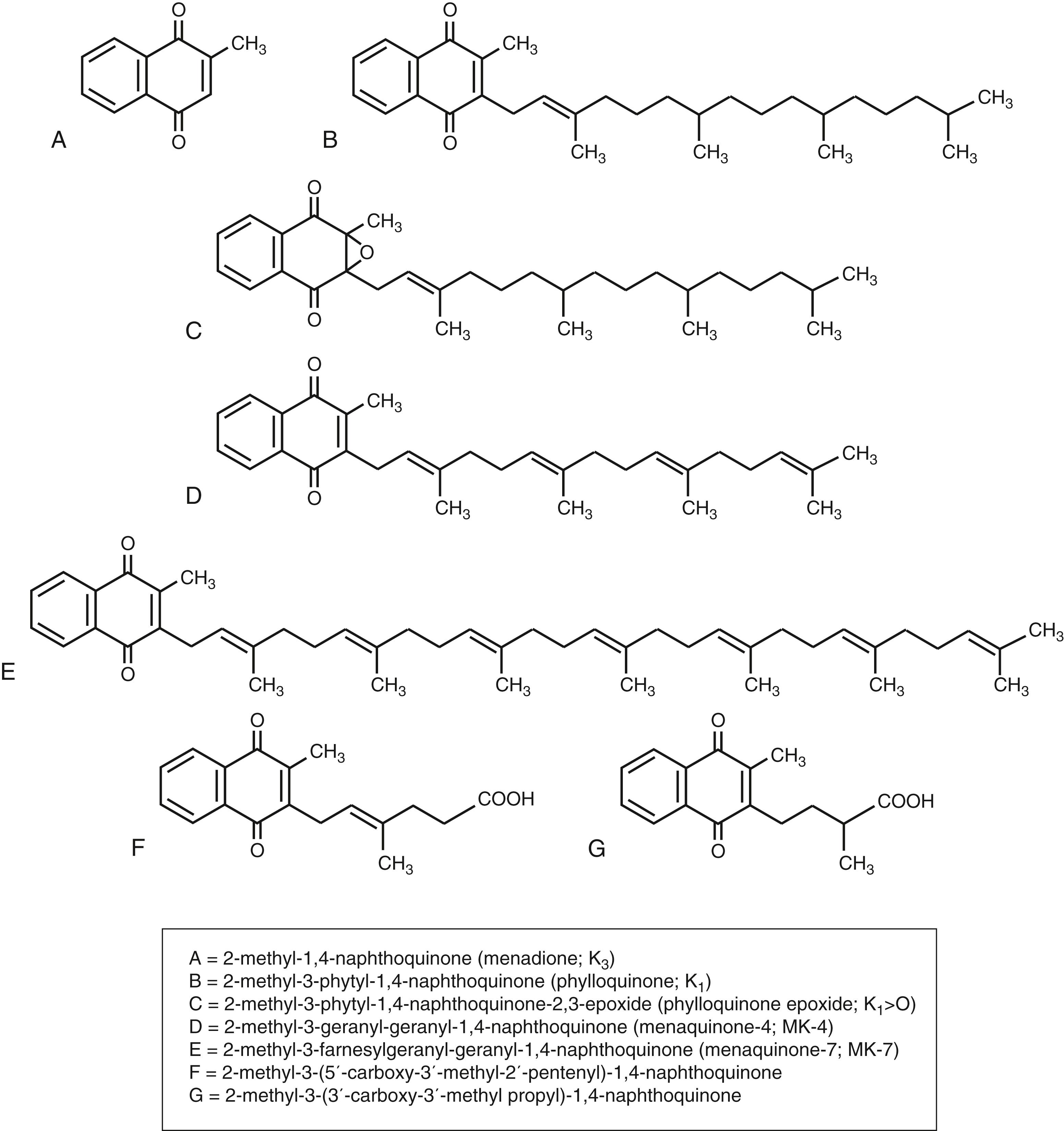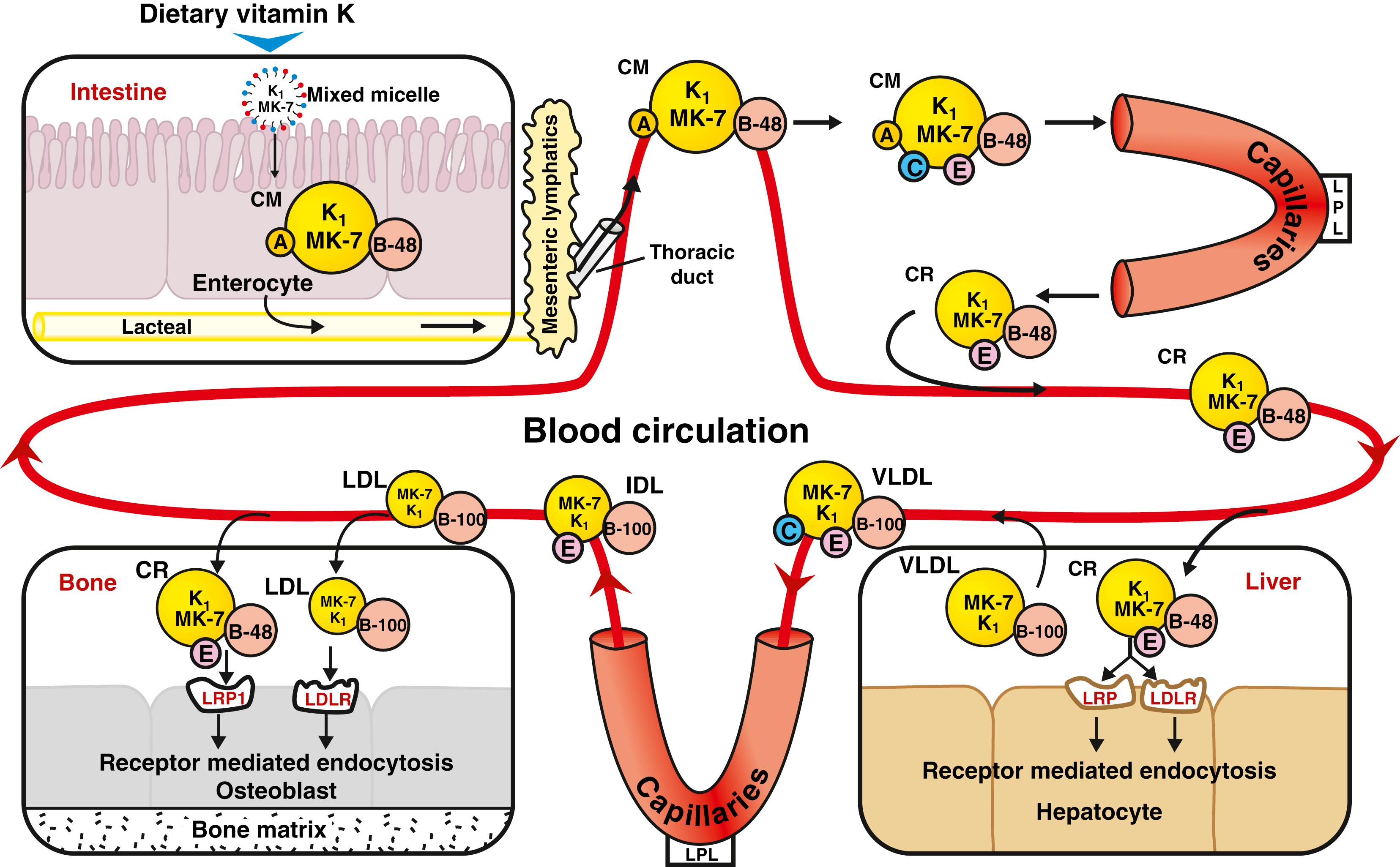Physical Address
304 North Cardinal St.
Dorchester Center, MA 02124
In his classic studies in the 1930s, Henrik Dam identified vitamin K as an essential fat-soluble antihemorrhagic factor. Later studies pinpointed the bleeding disorder caused by a dietary deficiency of vitamin K to a lack of four coagulation proteins, namely prothrombin (factor II) and factors VII, IX, and X, all of which are synthesized in the liver. Descriptions of a bleeding syndrome in newborns that had the hallmarks of vitamin K deficiency first appeared in 1894. This syndrome was originally called hemorrhagic disease of the newborn but was renamed in the 1990s as vitamin K deficiency bleeding (VKDB) of early infancy to clarify both its etiology and that it often occurs beyond the immediate newborn period. In 1974 it was established that vitamin K serves as a cofactor for a microsomal enzyme, γ-glutamyl carboxylase (GGCX), which catalyzes the conversion of specific peptide-bound glutamate (Glu) residues to γ-carboxyglutamate (Gla) residues. This posttranslational modification of Glu to Gla is essential for the biologic activity of vitamin K–dependent proteins (VKDP); hence they are often known as Gla proteins. Other significant discoveries in the 1970s were that γ-glutamyl carboxylation was intimately linked to the enzyme vitamin K epoxide reductase (VKOR) and that this enzyme was inhibited by vitamin K antagonists (VKA) such as warfarin. The discovery of γ-glutamyl carboxylation led to the identification of a plethora of Gla proteins. Among them are proteins C and S, which together play an anticoagulant role in the negative feedback control of coagulation. Other Gla proteins are known or suspected to play roles in processes as diverse as bone and cardiovascular mineralization, energy metabolism, immune response, brain metabolism, and the growth, survival, and signaling of cells. , In the context of the fetus and neonate, the only clinical syndrome firmly connected to a noncoagulation function of vitamin K is an embryopathy belonging to the chondrodysplasia punctata spectrum of disorders that are characterized by abnormal calcium deposition during endochondral bone formation. Vitamin K–related factors identified in the etiology of chondrodysplasia punctata include maternal dietary deficiency, or exposure to VKA, fetal mutations of key enzymes involved in vitamin K metabolism (GGCX or VKOR), and mutations of matrix Gla protein (MGP), which is a known inhibitor of calcification. Bleeding due to dietary vitamin K deficiency is extremely rare in adults. In contrast, a window exists from birth to approximately 6 months of age when the human infant is exposed to a small but potentially life-threatening risk for VKDB. Three subtypes of VKDB are recognized according to the age of presentation, namely early (first 24 hours), classic (between days 2 and 7), and late (between day 8 and 6 months). Late VKDB, with a peak incidence between 3 and 8 weeks, is generally regarded as the most insidious type because it typically presents as intracranial bleeding. Classic and late VKDB are primarily syndromes of breast-fed infants but are preventable by ensuring that newborns receive vitamin K prophylaxis.
Vitamin K is the family name for a series of lipophilic isoprenoid quinones that possess a common 2-methyl-1,4-naphthoquinone ring structure (menadione) and a variable alkyl side chain at the 3-position ( Fig. 30.1 ). The major dietary form phylloquinone (vitamin K 1 ) has a phytyl side chain and is synthesized by photosynthetic tissues of plants. Another subfamily of menaquinones (vitamin K 2 ) are predominately synthesized by bacteria and have multiprenyl side chains, the number of prenyl units being indicated by a suffix (i.e., menaquinone-n, abbreviated MK-n). Menadione has no cofactor activity per se but can be prenylated in vivo to the biologically active menaquinone-4 (MK-4). An important discovery is that the menadione precursor required for MK-4 biosynthesis can be derived from phylloquinone catabolism in the intestine.

Vitamin K occurs in breast milk mainly as phylloquinone and MK-4 (at approximately half the concentrations of phylloquinone) with trace concentrations of the longer side forms, MK-6 to MK-8. , Using standardized sampling techniques, mean concentrations of phylloquinone in colostrum and mature human milk were 2 μg/L and 1 μg/L, respectively. MK-4 in breast milk is derived from maternal dietary phylloquinone, either selectively taken up or synthesized by the mammary gland. An important determinant of neonatal vitamin K status lies in the large disparity in the daily intakes of phylloquinone in breast-fed and formula-fed infants that typically average 1 μg/day and 50 μg/day, respectively. The relevance of MK synthesized by gut microflora to vitamin K nutrition is controversial, but the weight of evidence suggests that they do make a significant contribution to hepatic requirements. ,
A schematic illustration of the metabolic processes and pathways that lead from the intestinal absorption of dietary vitamin K to its plasma transport and entry into cells is shown in Fig. 30.2 . Most of the available data pertain to phylloquinone and have been reviewed in detail. The physicochemical principles governing the intraluminal phase of intestinal absorption of dietary vitamin K were established in the 1970s and share several common features with other fat-soluble vitamins. Thus, in the upper intestine, dietary vitamin K is emulsified by bile salts and incorporated into mixed micelles containing the products of pancreatic hydrolysis (2-monoglycerides and fatty acids). These mixed micelles are taken up by enterocytes and packaged into chylomicrons (CM) before being secreted into the lymph and entering the blood via the thoracic duct. Once within the blood, CM follow the well-delineated pathway of metabolism, of which a major feature is the gradual loss of their triglyceride content to generate chylomicron remnants (CR). The stripping of triglyceride from CM is catalyzed by lipoprotein lipase on the surface of endothelial cells lining the capillary beds within muscles and adipose tissue. This conversion of CM to CR is accompanied by the acquisition of apolipoprotein E (apo E) and the loss of apo A and apo C. The importance of CR to all fat-soluble vitamins is that they provide a vehicle for their delivery to the liver and to extrahepatic tissues. For vitamin K, there is still a lack of knowledge of the molecular sequences and mechanisms whereby the various lipoprotein fractions acquire and lose their cargo of different molecular forms of vitamin K, so our current knowledge is limited to extrapolations from studies of plasma kinetics and analysis of the vitamin K content of different lipoprotein fractions. The molecular form of vitamin K with the highest concentrations in blood is phylloquinone. In both postprandial and fasting states, the bulk of phylloquinone in plasma is carried by triglyceride-rich lipoproteins (TRL) comprising CR and very low-density lipoproteins (VLDL). , The remainder is approximately equally distributed between low-density lipoproteins (LDL) and high-density lipoproteins (HDL). Different molecular forms of vitamin K exhibit marked differences in their plasma kinetics. In general, phylloquinone and MK-4 are cleared rapidly from the circulation, whereas long-chain MK are cleared much more slowly. , A comparison of the lipoprotein distribution of phylloquinone, MK-4, and MK-9 showed that during the first 4 hours after a meal, all molecular forms were predominately associated with TRL. Thereafter, there was divergence in lipoprotein distribution. MK-4 appeared very early in LDL and HDL, and by 8 hours 80% of MK-4 was carried by LDL. In contrast, MK-9 was not found in HDL at any time point and did not appear in LDL until after 8 hours; thereafter the proportion of MK-9 in LDL increased as its proportion in TRL declined. By 24 hours, approximately 50% of MK-9 was present in the LDL fraction, and this increased to greater than 90% at 48 hours. Other studies suggest that the slow plasma clearance of MK-7 also results from its transfer to LDL.

Become a Clinical Tree membership for Full access and enjoy Unlimited articles
If you are a member. Log in here